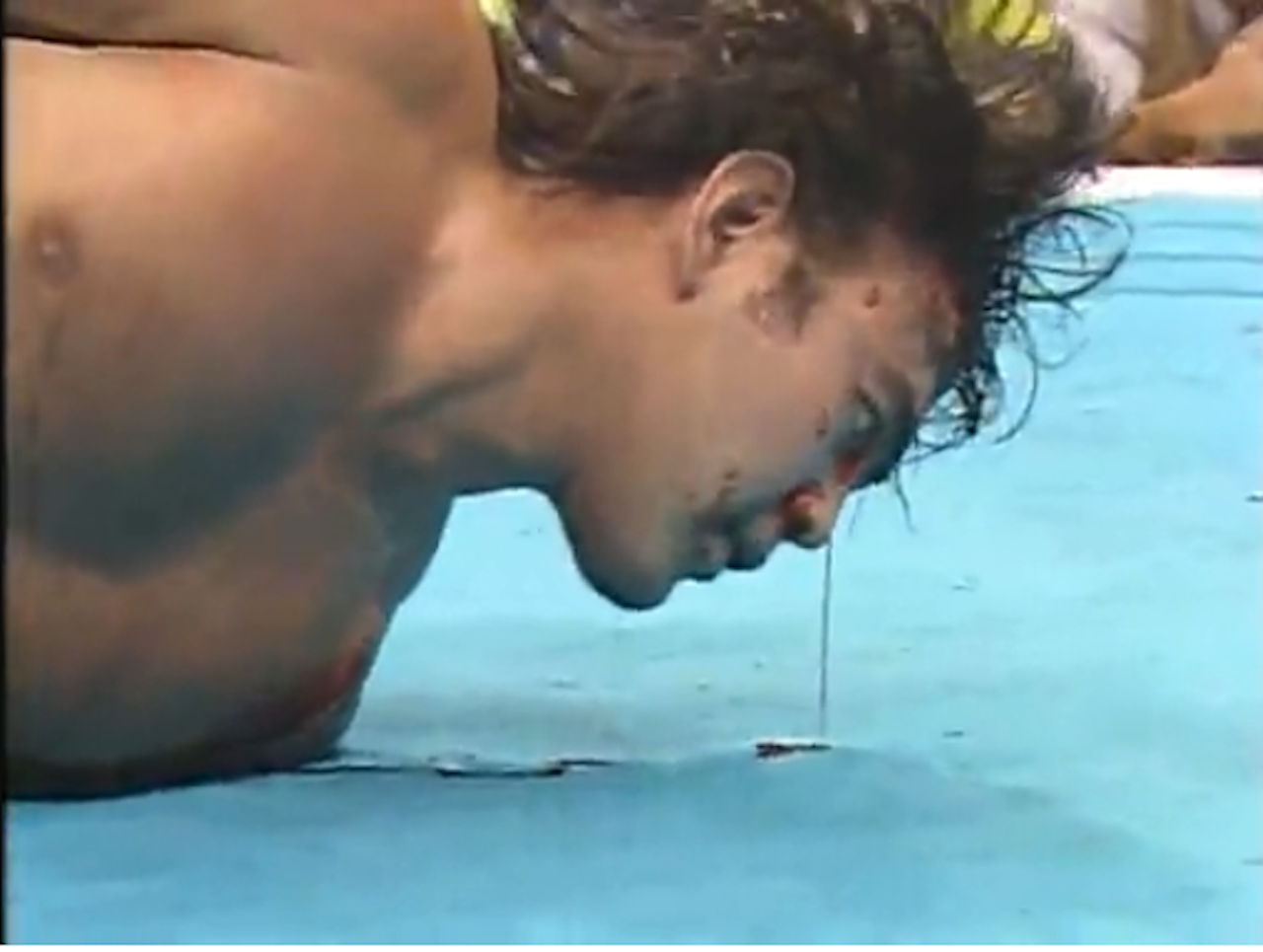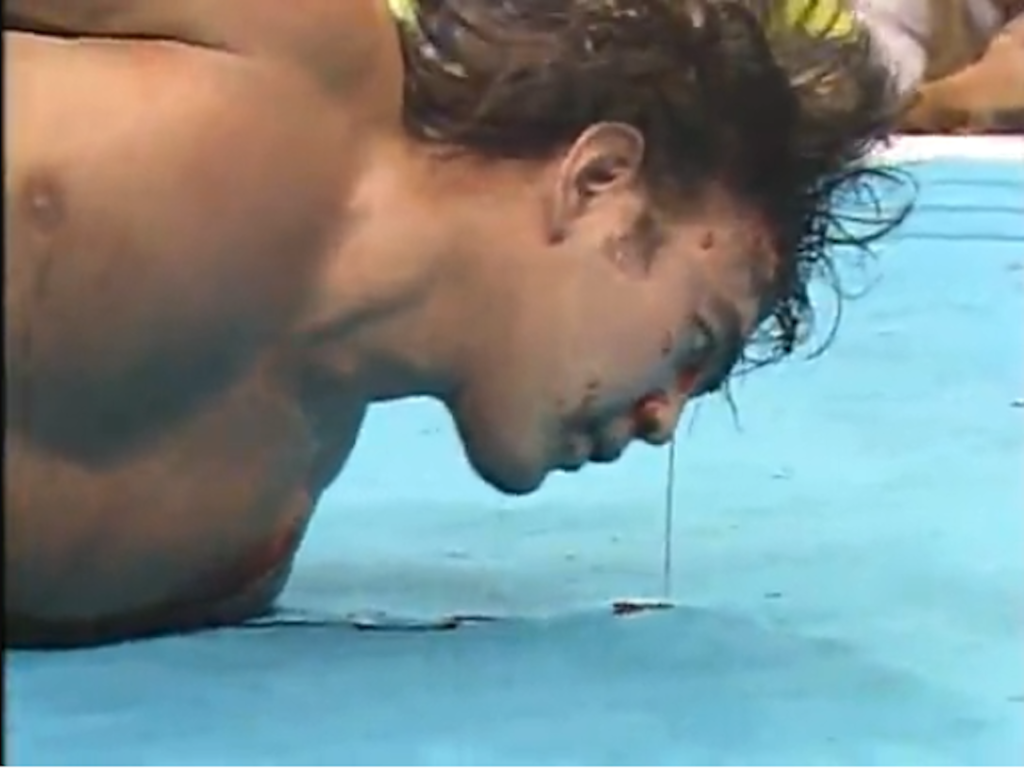With Keiji Muto, a.k.a. The Great Muta, approaching his retirement match, it’s important to look what his contributions to pro-wrestling. Much has already been said and written of Muto/Muta’s in-ring influence, titles, accolades, and influence. So instead, today we’ll revisit something that wrestling fans created in his honor: The Muta Scale.
In simple terms, the Muta Scale is an informal, fan-made way of measuring how much a wrestler bleeds during a match. Over the decades, it has been used to measure just how bloody some matches are. For some fans, a bloodier match is a more exciting or dramatic one. For others, more blood means a match veers away from performance and more into “real” violence.

The Muta Scale
And while blood has been an integral part of wrestling matches for decades stateside, how one was made to bleed was also important. Blading, the act of cutting one’s forehead to draw blood, was banned in some Japanese promotions like All Japan. At the same time, it was commonplace in smaller promotions and especially on the hardcore/deathmatch circuit. And for a long time, blading was seen as more of an American wrestling concept and not a Japanese one.
So when the Keiji Muto came back to Japan after his American excursion, he brought some of his lessons with him. That included the importance of blood, which was still rare in his home country. This was especially true given the notoriety of a match from decades earlier between Rikidozan and Freddie Blassie. That match drew so much blood that it was said that some elderly Japanese viewers suffered health problems from the sight of so much blood.
Decades later, Muta sought to live up to that match’s infamy. He wanted New Japan’s audience to think that he and Hase truly hated each other. And so, the match between Muta and Hase that birthed the Muta Scale was something truly special.
That led to this match: Muta vs. Hase, December 14th, 1992, which is still considered to be arguably the bloodiest wrestling match in modern times.
It wasn’t a typical New Japan match. Instead of being centered on sportsmanship, combat skill, and a sense of professionalism, this match was all about carnage. It was a hardnosed brawl with a few wrestling moves sprinkled in. Both men made liberal use of weapons including tables and non-gimmicked chairs.
As the match progressed, both wrestlers started using more dangerous weapons. Eventually, Muta grabbed a ring spike, only for Hase to take it and then hit Muta’s head with it. Then Muta bladed…way more than anyone expected. Blood poured from his forehead in a consistent stream.

Muta entered the match with red face paint and looked like this:


The Muta Scale –
Why the match matters
This match became the unofficial standard-bearer for bloody matches in mainstream promotions. Fans on online forums and discussion boards used this match as a template to measure how bloodiness of a match. As the standard-bearer, this match was rated 1.0 on a scale of 0-1. Whenever a match got bloody, fans would rate it “X Muta” to describe how bloody it was.
It served dual purposes: to showcase a match’s sense of carnage and to warn that matches could possibly get too bloody. Plenty of famous matches have had their share of blood. Undertaker vs. Michaels at Badd Blood 1997, Triple H vs. Ric Flair at Taboo Tuesday 2005, Bret Hart vs. Steve Austin at WrestleMania 13, and many more have featured tons of blood loss from at least one of the wrestlers involved.
But to this day, Hase vs. Muta remains the litmus test for bloody wrestling battles. To this very day, wrestling fans used Muta’s performance here to rate bloodiness. Muta bled for his craft like few others. He was so determined to deliver on what was promised to the fans that he left pools of blood on the ring canvas big enough to be seen from multiple ringside cameras.
A few matches have actually come very close to reaching it. Undertaker vs. Brock Lesnar at No Mercy 2002 was exceptionally bloody and at one point blood shot out of Undertaker’s forehead like a fountain. The Mass Transit Incident in ECW saw one person get rushed to the hospital due to being cut too deeply.
But there’s one match that has become infamous for blading too much, to the point that a few wrestling fans and insiders once rated it 1.2 Muta. That match was Eddie Guerrero vs. JBL at Judgment Day 2004. Guerrero cut himself way too deeply to sell a chairshot to the head. When the camera zoomed in on him, blood literally poured from his head like a cascading waterfall. And when Eddie got backstage after the match, he was said to have gone into shock from the blood loss.
The reason this isn’t called the ‘Eddy Scale’ is because his bladejob there was done wrong. He cut too deep and caused himself far more harm than necessary. Muta, on the other hand, cut himself deeply but not badly enough to hurt himself any more than he would in a ‘normal’ wrestling match. Muta’s blading was an act of performance; Eddie’s was a botch.
While bleeding in wrestling is somewhat rare nowadays (save for a handful of blood enthusiasts on the independent circuit and in AEW), it’s not likely to be abandoned forever anytime soon. Bleeding has helped make big matches better and there are many examples in wrestling history of bleeding working to a match’s favor.
And if you need another reason to thank Muta for his many contributions to pro-wrestling, look no further than this.
You can watch the Scale-birthing Muta vs. Hase match here.

